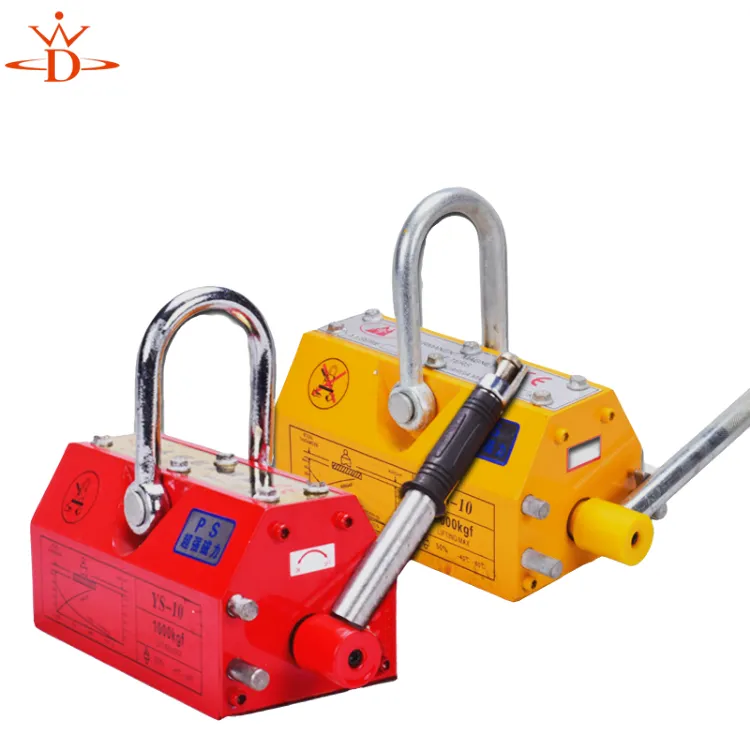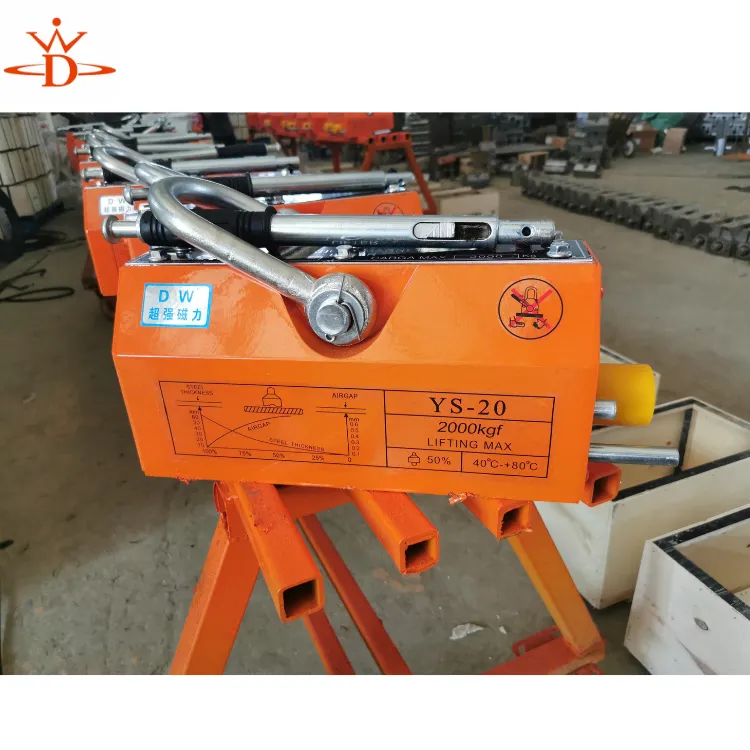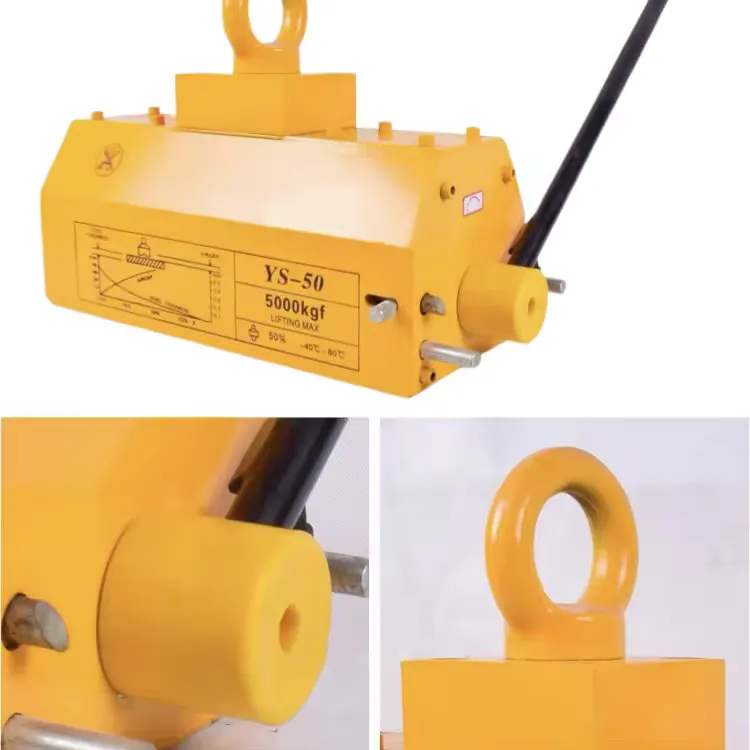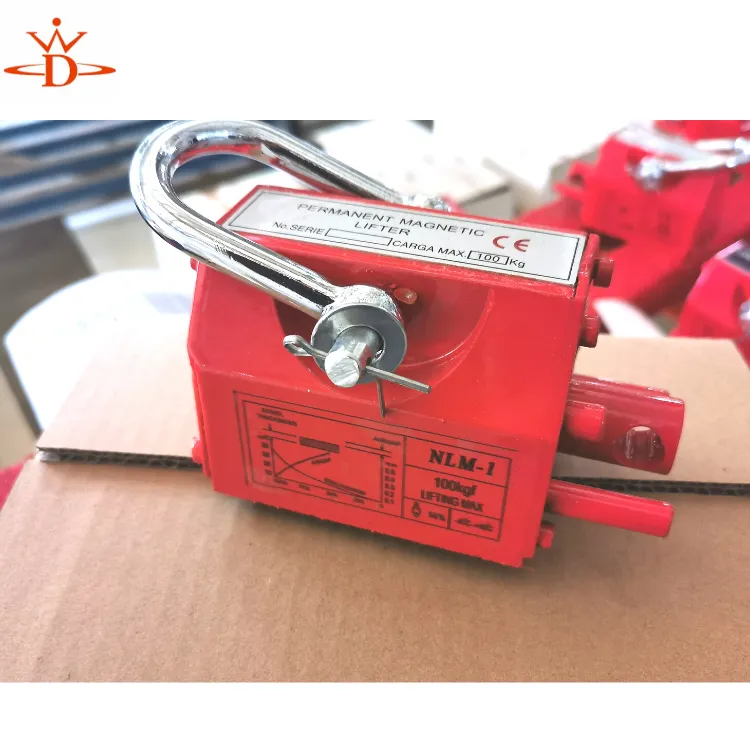Permanent Lifting Magnets | Safe & Efficient | Up to 1000kg
Unlocking Efficiency: The Power of Permanent Lifting Magnets in Modern Industry
In the dynamic landscape of material handling and industrial operations, efficiency, safety, and reliability are paramount. Traditional methods of lifting heavy ferrous materials often present challenges related to time consumption, labor intensity, and potential hazards. This is where the innovation of the permanent lifting magnet emerges as a game-changer. These robust devices offer a contact-free, power-independent solution for lifting and moving steel plates, blocks, and various ferrous workpieces, dramatically enhancing productivity and safety across numerous sectors. This article delves into the intricate details of these indispensable tools, exploring their design, manufacturing, applications, and the distinct advantages they bring to the table.
Understanding Permanent Magnetic Lifters: Technology & Industry Trends
A permanent magnetic lifter harnesses the power of strong, rare-earth magnets, typically Neodymium-Iron-Boron (NdFeB) or Samarium-Cobalt (SmCo), to generate a powerful magnetic field without requiring external electricity. This intrinsic design offers inherent safety, as the lifting force remains active even during power failures, a critical advantage over electro-magnets. The operational mechanism involves a simple lever or handle that mechanically shifts the magnet array, engaging or disengaging the magnetic field. Industry trends point towards compact designs, higher lifting capacities like the lifting magnet 100kg, and enhanced safety features, pushing the boundaries of what these devices can achieve. Innovations also focus on improved demagnetization mechanisms and more durable casings to withstand harsh industrial environments, ensuring longevity and consistent performance.

These advancements cater to a growing demand for cost-effective and reliable lifting solutions that minimize operational risks. The ability of a permanent lifting magnet to operate independently of power sources not only makes it energy-efficient but also highly adaptable for various outdoor or remote applications where power access might be limited. The global market for material handling equipment continues to see strong growth, projected to reach over USD 200 billion by 2027, driven significantly by the adoption of automated and semi-automated lifting solutions, including advanced magnetic lifters. This growth underscores the increasing reliance on efficient tools like the magnetic lifter 200 kg for streamlined logistics and manufacturing processes.
The Dawei Permanent Magnetic Lifter-YS Type: Engineered for Excellence
The Dawei Permanent Magnetic Lifter-YS Type stands out as a prime example of engineering excellence in magnetic lifting technology. With a rated load capacity ranging from 100 KGS to 5000 KGS, this series is meticulously designed to meet the diverse and demanding requirements of modern industrial environments. Each unit is constructed with high-grade magnetic materials and robust mechanical components, ensuring maximum safety factor and prolonged operational life. The YS type lifters are distinguished by their compact structure, lightweight design, and ease of operation, making them an ideal choice for a wide array of lifting tasks, from delicate workshop maneuvers to heavy-duty material handling in fabrication plants.

Beyond their impressive lifting capabilities, Dawei YS type lifters incorporate essential safety mechanisms to prevent accidental release, such as the safety button for preventing handle rotation in the loaded position. This commitment to safety, coupled with the inherent energy independence of a permanent lifting magnet, significantly reduces operational costs and environmental impact by eliminating the need for electricity during lifting operations. Whether handling thin sheets or thick steel slabs, the Dawei Permanent Magnetic Lifter-YS type ensures secure and efficient material transfer, contributing to a safer and more productive workspace.
Precision Engineering: The Manufacturing Process of a Permanent Lifting Magnet
The creation of a high-performance permanent lifting magnet involves a meticulous manufacturing process that ensures durability, reliability, and optimal magnetic force. It typically begins with the selection of premium-grade magnetic alloys, primarily sintered Neodymium magnets, known for their exceptional coercivity and remnant magnetization. These raw materials undergo precise processing, starting with melting and casting, followed by powder metallurgy techniques to form the specific magnetic blocks. The external casing and mechanical components, crucial for structural integrity and user safety, are typically made from high-strength alloy steel, often subjected to forging and advanced CNC machining to achieve exact dimensions and smooth operation.

Quality control is integrated at every stage. For instance, magnetic flux density is rigorously tested using gauss meters, and pull-off force is verified on specialized test benches to ensure the lifter meets and exceeds its rated capacity, typically with a safety factor of 3:1 or 3.5:1. Components undergo non-destructive testing, such as magnetic particle inspection, to detect any potential flaws. Final assembly includes strict adherence to international standards like ISO 9001 for quality management and ANSI/ASME B30.20 for Below-the-Hook Lifting Devices, guaranteeing compliance and safety. This stringent manufacturing ensures a lifespan often exceeding 10 years with proper maintenance, even in demanding industrial environments like metallurgy or shipbuilding, where tools like the permanent magnetic lifter 1000kg are indispensable.
Technical Specifications and Performance Data
Selecting the right permanent lifting magnet requires a thorough understanding of its technical specifications and performance characteristics. The following table provides a general overview of common parameters, with specific figures varying based on model and manufacturer. It highlights key metrics such as rated lifting capacity, safety factor, and net weight, which are crucial for operational planning and safety compliance. Dawei's YS series is designed to offer optimal performance across its entire range, from lighter capacities suitable for workshop use to heavy-duty models like the 1000 lb lifting magnet required for larger industrial applications.
| Model | Rated Lifting Capacity (KGS / lbs) | Max Pull-Off Force (KGS) | Net Weight (KGS) | Safety Factor | Applicable Plate Thickness (mm) |
|---|---|---|---|---|---|
| YS-100 | 100 / 220 | 300 | 3 | 3:1 | ≥5 |
| YS-200 | 200 / 440 | 600 | 6 | 3:1 | ≥6 |
| YS-500 | 500 / 1100 | 1500 | 15 | 3:1 | ≥8 |
| YS-1000 | 1000 / 2200 | 3000 | 30 | 3:1 | ≥10 |
| YS-2000 | 2000 / 4400 | 6000 | 65 | 3:1 | ≥12 |
| YS-5000 | 5000 / 11000 | 15000 | 200 | 3:1 | ≥15 |
It's vital to note that the actual lifting capacity can be affected by factors such as material thickness, surface roughness, air gap, and alloy composition. A general rule of thumb is that for optimal performance, the workpiece should have a clean, flat surface and be sufficiently thick to allow the magnetic field to fully penetrate. The specified safety factor provides a critical buffer, meaning the lifter's actual pull-off force is significantly higher than its rated capacity, ensuring safe operation even under less-than-ideal conditions.
Diverse Applications Across Industries
The versatility of the permanent lifting magnet makes it indispensable across a multitude of industries, streamlining operations and enhancing safety. In the metallurgy and steel industry, these lifters are used daily for handling steel plates, tubes, rods, and molds during production, storage, and transportation. Their ability to quickly attach and release loads without manual intervention significantly reduces turnaround times and minimizes the risk of worker injury. For instance, a permanent magnetic lifter 1000kg can easily manage large steel sheets moving from cutting to bending stations.

In shipbuilding and heavy fabrication, the demand for precise and secure handling of massive metal components is constant. Magnetic lifters provide a safe and efficient means to move hull sections, beams, and large assemblies. Similarly, the petrochemical industry utilizes these devices for handling pipes, valves, and structural steel in maintenance and construction, where non-sparking tools are often preferred for safety. Furthermore, in manufacturing and general engineering workshops, from small-scale operations requiring a lifting magnet 100kg to large factories using several permanent magnetic lifter 1000kg units, they simplify the loading and unloading of machinery, dies, and raw materials, offering substantial energy savings compared to powered alternatives. Their inherent resistance to corrosion due to robust casing designs makes them suitable even in challenging environments like foundries or outdoor storage yards.
Unmatched Advantages & Safety Features
The advantages of integrating a permanent lifting magnet into material handling operations are multifaceted. Foremost is their unparalleled safety. Without the need for electricity, there is no risk of load drop due to power failure, and no complicated wiring or battery maintenance is required. This drastically reduces potential hazards and simplifies operational procedures. The mechanical switching mechanism, often featuring a safety lock, ensures the magnetic force is securely engaged before lifting and cannot be accidentally disengaged. This makes them inherently safer than chains or slings for certain applications, as they prevent crushing hazards or damage to delicate surfaces.

Economically, permanent lifting magnets offer significant energy savings. Unlike electromagnets which consume power continuously, permanent magnets only require energy for the brief moment of switching the magnetic field on or off. This leads to substantial reductions in electricity costs over their long operational lifespan. Furthermore, their compact design and light weight (relative to their lifting capacity) make them highly portable and adaptable to various crane systems, overhead hoists, or even forklifts with suitable attachments. The low maintenance requirements, due to fewer moving parts and robust construction, further contribute to a lower total cost of ownership, making them a wise investment for any facility handling ferrous materials.
Customization and Tailored Solutions
While standard models like the Dawei YS series cater to a broad spectrum of industrial needs, specific lifting challenges often require tailored solutions. Leading manufacturers understand that not all workpieces are uniform or easily accessible. Custom-designed permanent lifting magnets can address unique requirements such as lifting perforated plates, handling materials with irregular shapes, or operating in extreme temperatures. This involves designing specific pole shoe configurations, adjusting magnet strength, or integrating specialized suspension points. Engaging with an experienced manufacturer allows for a collaborative design process, ensuring the final product perfectly aligns with operational demands and safety protocols, optimizing both performance and return on investment.

For instance, a client in the automotive stamping industry might require a magnet designed to lift multiple thin sheets simultaneously without deformation, or a forging plant might need a high-temperature resistant permanent lifting magnet capable of handling hot workpieces. Such custom solutions are developed through extensive research and development, leveraging advanced simulation tools and rigorous testing to ensure they meet stringent performance and safety standards. This bespoke approach underscores the commitment of industry leaders to provide comprehensive material handling solutions, extending beyond off-the-shelf products.
Real-World Impact: Application Case Studies
The tangible benefits of permanent lifting magnets are best illustrated through their real-world application. Consider a medium-sized fabrication shop that previously relied on slings and clamps for moving steel plates. The process was slow, required two operators, and frequently resulted in minor surface damage. By implementing a Dawei YS-500 permanent magnetic lifter 1000kg, they reduced the lifting time by 60%, cut labor requirements to a single operator, and eliminated surface damage. This transition not only improved efficiency but also significantly enhanced workplace safety, leading to a demonstrable ROI within months.

Another compelling case involves a large-scale steel distribution center using multiple magnetic lifters, including several 1000 lb lifting magnet units, to organize and retrieve inventory. The quick attach/release mechanism drastically sped up the loading and unloading of trucks, improving logistics flow and reducing vehicle idle time. These examples underscore how robust, well-engineered magnetic lifters contribute to seamless operations, decreased overhead, and an overall safer working environment, making them an indispensable asset for any business involved in metal processing or handling.
Ensuring Trust and Reliability: Quality Assurance & Support
For B2B decision-makers, trust and reliability are paramount. A reputable manufacturer of permanent lifting magnets like Dawei demonstrates this through rigorous quality assurance, comprehensive certifications, and robust customer support. Products are typically manufactured under ISO 9001 certified quality management systems, ensuring consistent production standards. Each lifter undergoes individual load testing, often accompanied by a test certificate confirming its actual pull-off force and compliance with international safety standards like EN 13155. Dawei’s commitment to quality is further evidenced by its years of service in the hoisting equipment industry and a network of satisfied clients.
Beyond product quality, effective customer support is crucial. This includes clear documentation, readily available spare parts, and responsive technical assistance. Typical delivery cycles are maintained efficient to minimize downtime for clients, and comprehensive warranty commitments underscore confidence in product durability. Clients benefit from accessible service teams, ready to provide guidance on optimal usage, maintenance tips, or troubleshoot any issues, ensuring continuous, reliable operation of their permanent lifting magnet investment.
Frequently Asked Questions (FAQ) About Permanent Lifting Magnets
- Q: How does a permanent lifting magnet maintain its strength over time?
- Q: What is the minimum thickness of material a permanent magnetic lifter can effectively lift?
- Q: Can a permanent magnetic lifter be used on painted or rusty surfaces?
- Q: What is the typical warranty period for Dawei Permanent Magnetic Lifters?
A: High-quality permanent magnets, typically made from rare-earth alloys, have high coercivity, meaning they resist demagnetization very effectively. With proper use and storage (avoiding extreme heat or strong opposing magnetic fields), their strength can last for decades with negligible degradation, ensuring a long operational life for the permanent lifting magnet.
A: The minimum effective thickness varies by lifter model and material properties, but generally, for full rated capacity, most lifters require a minimum thickness of 5-10mm (0.2-0.4 inches) for steel. For thinner sheets, capacity decreases significantly, and specialized multi-pole lifters might be required, or a lower capacity lifting magnet 100kg might be sufficient.
A: While a permanent lifting magnet can technically adhere to painted or slightly rusty surfaces, its lifting capacity will be significantly reduced due to the air gap created by the coating or rust. For optimal safety and full rated capacity, it is always recommended to use the lifter on clean, flat, and bare ferromagnetic surfaces. A rule of thumb is that any air gap severely diminishes performance.
A: Dawei typically offers a standard warranty period of one year for its Permanent Magnetic Lifters, covering manufacturing defects. Specific warranty terms and conditions may vary, and customers are encouraged to consult the product documentation or contact Dawei directly for detailed information and support, reflecting strong trustworthiness.
Conclusion: The Future of Material Handling
The evolution of the permanent lifting magnet has positioned it as an indispensable tool in modern industrial material handling. From their inherent safety advantages and energy efficiency to their robust construction and adaptability across diverse sectors like petrochemical, metallurgy, and general manufacturing, these lifters offer a compelling solution for businesses seeking to optimize their operations. Products like the Dawei Permanent Magnetic Lifter-YS type, with their wide range of capacities and commitment to stringent quality standards, exemplify the peak of this technology. Investing in a high-quality permanent lifting magnet is not merely an acquisition of equipment; it is a strategic decision towards fostering a safer, more efficient, and ultimately more profitable working environment. As industries continue to seek advanced, reliable, and sustainable solutions, the role of these magnetic workhorses will only grow in significance.
References
- Manufacturing Today, "Innovations in Magnetic Lifting Technology."
- Industrial Safety Journal, "Safety Protocols for Material Handling Equipment."
- Journal of Applied Physics, "Rare-Earth Magnets: Properties and Applications."
- Global Market Insights, "Material Handling Equipment Market Size."
- ISO.org, "ISO 9001: Quality Management Systems - Requirements."
-
Dawei Hand Pallet Truck 1200mm, 2000–5000 KGS Heavy-DutyNewsNov.17,2025
-
Dawei Hand Pallet Truck, Fork Length 1200mm, 2000–5000kgNewsNov.17,2025
-
Large Equipment Movers – Safe, Insured & On-Time ServiceNewsNov.17,2025
-
Machine Moving Dollies | Heavy-Duty, Low-Profile, SafeNewsNov.17,2025
-
Permanent Lifting Magnet - Heavy-Duty, Safe, Quick ReleaseNewsNov.11,2025
-
PML 1000 Lifting Magnet - Heavy-Duty, Safe, No PowerNewsNov.11,2025
-
Large Equipment Movers: Safe, Fast, Certified ProsNewsNov.11,2025
